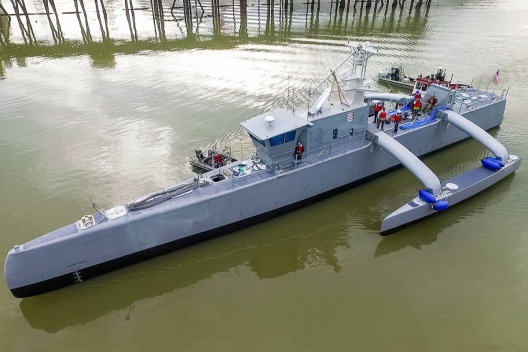 During war games played off the coast of Florida last year, a nuclear-powered French attack submarine, Saphir, eluded America’s sub-hunting aircraft and vessels with enough stealth to sink (fictitiously) a newly overhauled American aircraft-carrier, Theodore Roosevelt, and most of her escort.
During war games played off the coast of Florida last year, a nuclear-powered French attack submarine, Saphir, eluded America’s sub-hunting aircraft and vessels with enough stealth to sink (fictitiously) a newly overhauled American aircraft-carrier, Theodore Roosevelt, and most of her escort.
An account of the drill on a French defence-ministry website was promptly deleted, but too late for it to go unnoticed.
Nor was this French victory a fluke. In 2006, in what was very far from being a war game, a Chinese diesel-electric submarine surfaced near Okinawa within torpedo range of another American carrier, Kitty Hawk, without having been detected by that carrier’s escort of more than a dozen vessels and anti-submarine aircraft. And, from the point of view of carrier-deploying navies, things are threatening to get worse. Saphir, launched in 1981, hardly represents the state of the art in underwater undetectability; in the decade since the Okinawa incident diesel-electrics have become even quieter. For an inkling of the silence of the new generation of such subs when they are running on battery power alone, without their engines turning, Jerry Hendrix, a former anti-submarine operations officer on the Theodore Roosevelt, asks: “How loud is your flashlight?”
Moreover, submarines are spreading. Since the cold war ended, the number of countries deploying them has risen from a dozen or so to about 40. Many of the newcomers are not part of the Western system of alliances. Some are actively hostile to it. And more may join them. A secondhand diesel-electric boat—not state of the art, admittedly, but effective nevertheless—can be had for as little as $350m.
Worse, for those trying to defend ships from submarine attack, Western powers have routinely cut anti-submarine spending since the end of the cold war. American carriers retired the S-3 Viking submarine-hunting warplane in 2009, leaving shorter-range helicopters to compensate. Since the Soviet Union’s demise the average surface escort of an American carrier has shrunk from six vessels to four….
Perhaps belatedly, but certainly determinedly, a new approach to the submarine threat is now being developed. It is based on a simple principle: since submarines are hard to detect, when you do find one you should never let go.
Shadowing threatening submersibles is nothing new. Trailing something is a much easier sensory task than discovering it in the first place, when you have an entire ocean to search. But at the moment this job is done by destroyers and (for those that have them) nuclear submarines. These cost billions of dollars to build and tens of millions a year more to run. Instead, the idea is to use smallish unmanned ships—marine drones, in effect—to do the job. These will be packed with enough sensors and artificial intelligence to follow adversaries’ submarines automatically.
Half a dozen Western naval powers are conducting the R&D needed to build these, according to Eric Wertheim, author of the US Naval Institute’s reference doorstop “Combat Fleets of the World”. America is furthest along. In June its Office of Naval Research and its Defence Advanced Research Projects Agency, DARPA, began tests in the Pacific of the Sea Hunter, an unmanned (and, for now, unarmed) 40-metre trimaran, pictured. It is designed to follow an enemy submarine from the surface relentlessly for months, even in high seas. While the crew of the boat being tailed will probably be able to hear their pursuer’s diesel engine, that is not really a problem. Short of a torpedo launch, which would be an act of war, “there’s nothing you can do about it”, says Nevin Carr, a retired rear admiral in the American navy who now works at Leidos, the firm which designed Sea Hunter….
Sound, whether of engines turning or sonar pulses returning, obeys the inverse-square law. Its strength changes in inverse proportion to the square of the distance it has travelled. That means it falls off fast. Ideally, therefore, detectors need to be close to their targets.
One way to do this, at least for home waters, is to have a dense grid of fixed detectors. One of the more advanced of these is Singapore’s. It consists of underwater buoys called acoustic nodes that are tethered to the sea bed two or three kilometres apart. These nodes can talk to each other. They communicate by broadcasting precisely calibrated vibrations through the water. At the moment they are sending test messages, but eventually they will be equipped with their own submarine-detecting sensors.
Image: US Navy’s Sea Hunter unmanned vessel (photo: DARPA)

